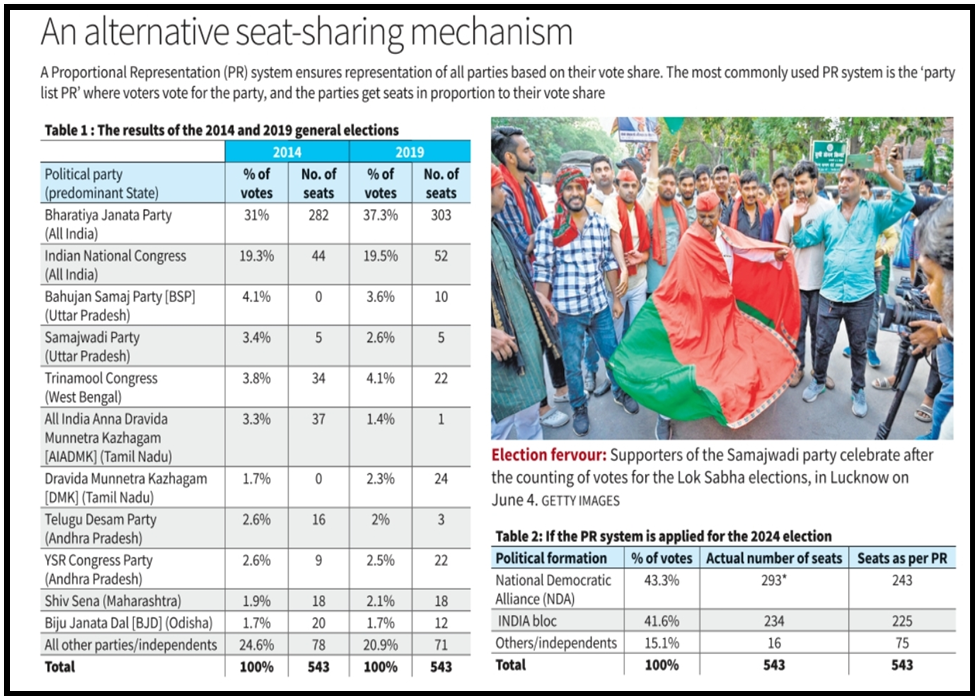IS IT TIME FOR PROPORTIONAL REPRESENTATION?
Syllabus:
GS 3:
- Indian Constitution: Features, Amendments and Significant Provisions.
- Structure, Organization and Functioning.
Why in the News?
The recent Lok Sabha election results have sparked discussions on the efficacy of the First Past the Post (FPTP) system in India. This has led to renewed interest in exploring Proportional Representation (PR) and Mixed Member Proportional Representation (MMPR) to ensure more equitable representation in the country’s diverse democracy.
Source: TH
Overview and Context
- Recent Election Results: In the recent Lok Sabha elections, the National Democratic Alliance (NDA) secured 293 seats with a 43.3% vote share, while the Opposition bloc INDIA won 234 seats with a 41.6% vote share. Other regional parties and independents, with 15% of the vote share, secured only 16 seats.
- Electoral System Critique: This disparity raises questions about the efficacy and fairness of the current First Past the Post (FPTP) electoral system.
- Global Examples: Various countries employ different electoral systems, such as Proportional Representation (PR) and Mixed Member Proportional Representation (MMPR), which could potentially offer more balanced representation.
- India’s Diversity: Considering India’s vast and diverse population, the suitability of these systems is a critical debate.
- Electoral Reform Discussion: There is ongoing discussion about whether India should adopt a more proportional system to ensure fair representation.
Understanding the First Past the Post System
- Basic Mechanism: The FPTP system declares the candidate with the most votes in a constituency as the winner. This system is used in democracies like the U.S., U.K., and Canada.
- Simplicity and Feasibility: FPTP is straightforward and practical, especially for large countries like India.
- Executive Stability: FPTP often leads to greater stability in parliamentary democracies by allowing a party/coalition to secure a majority without needing a majority of the total vote share.
- Representation Issues: A significant drawback of FPTP is that it can lead to over or under-representation of parties relative to their vote share.
- Historical Disparities: Historically, the Congress party won around 75% of seats with only 45-47% of the vote share in the first three elections after independence, highlighting the potential imbalances created by FPTP.
Proportional Representation Explained
- Basic Concept: The Proportional Representation (PR) system allocates seats based on the percentage of votes each party receives, ensuring representation aligned with voter preferences.
- Party List PR: The most common PR system is the party list method, where voters select a party rather than individual candidates. Seats are then distributed according to each party’s vote share.
- Minimum Thresholds: Typically, parties need to secure a minimum percentage of votes (e.g., 3-5%) to be eligible for seats.
- State/UT Application: In India, implementing PR should ideally be carried out at each State/Union Territory (UT) level to reflect its federal structure.
- Hypothetical Outcomes: If the 2024 election results were based on PR, parties would have been represented according to their vote share, leading to more equitable representation.
| Alternative Electoral Systems
Proportional Representation (PR) Systems:
Ranked Voting Systems:
Score Voting Systems:
|
Criticisms and Solutions
- Potential Instability: One main criticism of PR is that it may result in fragmented parliaments where no party or coalition can easily form a stable government.
- Proliferation of Parties: PR could lead to an increase in the number of political parties based on regional, caste, religious, and linguistic identities, potentially promoting divisive voting patterns.
- Current System’s Flaws: The existing FPTP system already allows for the formation of parties based on caste or communal considerations, indicating that PR may not worsen this issue.
- Addressing Instability: To counter potential instability, a mixed system like Mixed Member Proportional Representation (MMPR) can be considered.
- Minimum Vote Thresholds: Setting minimum thresholds for vote shares can help manage the proliferation of minor parties in the legislative houses.
Mixed Member Proportional Representation
- Combining Systems: MMPR combines elements of FPTP and PR. Constituencies elect one candidate through FPTP, while additional seats are filled based on parties’ overall vote percentages.
- International Examples: Germany and New Zealand use MMPR, balancing constituency representation with proportional allocation of additional seats.
- German Model: In Germany’s Bundestag, 50% of seats are filled through FPTP and the remaining 50% are allocated proportionally, ensuring balanced representation.
- New Zealand Model: New Zealand’s House of Representatives fills 60% of seats through FPTP and 40% through proportional representation.
- Suitability for India: This system could provide stability in India’s parliamentary democracy while ensuring fair representation for all parties based on their vote shares.
Way Forward for Electoral Reform
- Law Commission Recommendations: The Law Commission’s 170th report suggested experimenting with MMPR by filling 25% of seats through PR and increasing the total number of seats in the Lok Sabha.
- State/UT Level Implementation: Considering India’s federal structure, PR should be applied at the State/UT level rather than treating the entire nation as a single unit.
- Delimitation Exercise: The upcoming delimitation exercise based on the post-2026 Census offers an opportunity to implement MMPR, especially for incremental seats.
- Addressing Regional Disparities: Careful implementation is required to avoid disenfranchising states that might lose representation if seats are increased solely based on population.
- Balancing Interests: Introducing MMPR for a portion of seats can help balance stability and fair representation, addressing concerns of smaller and diverse states.
Conclusion
As India continues to evolve as a democracy, exploring electoral reforms like proportional representation and mixed member proportional representation can potentially lead to a more balanced and fair system. Implementing these changes thoughtfully, considering India’s unique federal and diverse nature, could enhance the democratic process and ensure that every vote truly counts.
Source:The Hindu
Mains Practice Question:
Discuss the merits and demerits of the First Past the Post (FPTP) electoral system in the context of Indian democracy. Evaluate whether adopting Proportional Representation (PR) or Mixed Member Proportional Representation (MMPR) could address the issues of representation in India’s parliamentary system..
Associated Article:




